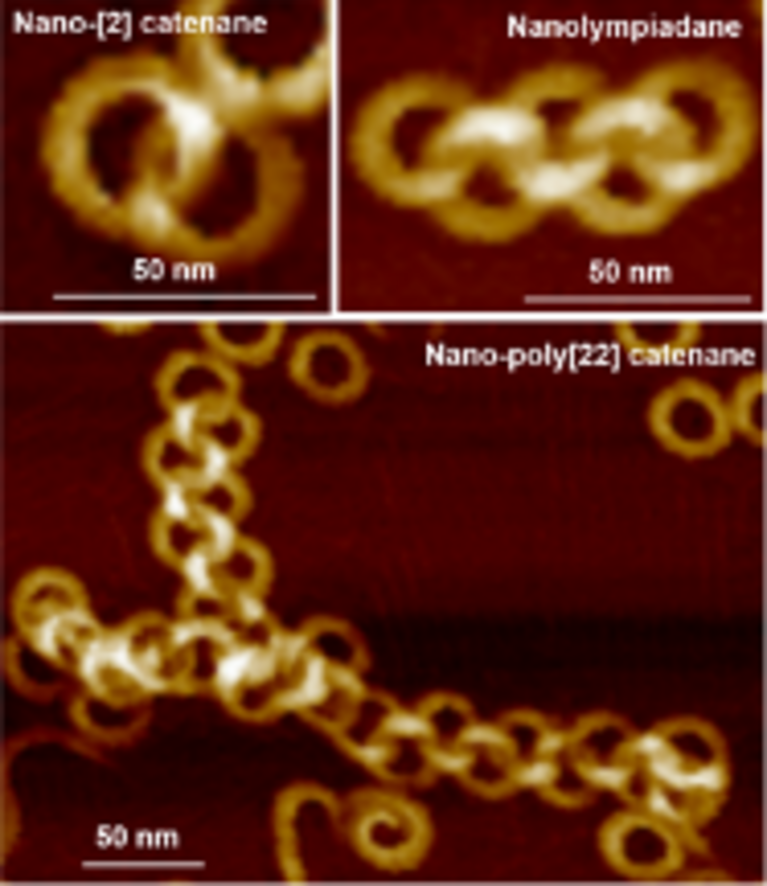July 16, 2020 – Press Release SUPSI/su
In 2016, the Nobel Prize in Chemistry was shared by Jean-Pierre Sauvage for the design and synthesis of molecular machines, after he managed to connect two ring-shaped molecules into what is called a "catenane". Unlike ordinary polymers, composed of monomers interconnected via covalent chemical bonds, in catenanes the constitutive building blocks are interlocked like rings in a chain, and can move relatively to each other. This imparts unique properties to these supramolecular materials in terms of absorption, conversion and dissipation of energy, super-elasticity, etc. The synthesis and characterisation of such structures are notoriously difficult, particularly when the fundamental rings themselves are not held together by strong covalent bonds.
Molecular self-assembly
The research groups from the Chiba University in Japan, the Scuola universitaria professionale della Svizzera italiana (SUPSI) in Switzerland, the Politecnico di Torino in Italy and the Keele University in UK, has now succeeded in forming and studying hierarchical structures composed of mechanically interlocked self-assembled rings, made solely from one elementary molecular ingredient. The results of this research work, led by Shiki Yagai from Chiba University, have now been published in the scientific journal Nature. “This is the first report on the creation of template-free nano-polycatenanes via molecular self-assembly, and molecular models played an important role in elucidating the secondary nucleation mechanism underpinning their formation”, says Giovanni M. Pavan, head of the Computational Materials Science Laboratory in the Institute for Mechanical Engineering and Materials Technology of SUPSI. Pavan and his team carried out multiscale molecular simulations for understanding the formation of the polycatenanes among others on “Piz Daint”.
By altering the self-assembly conditions in laboratory experiments, the international research group has been able to create intricate structures, including a nano-catenane with five interlocked rings in a linear arrangement. The arrangement has been named “nanolympiadane” in homage to the [5]catenane system “olympiadane” first reported by Fraser Stoddart and colleagues in 1994, and the well-known symbol of the Olympic games. The groups were able to probe these impressive structures composed of nano-rings using atomic force microscopy, X-ray and neutron scattering.
Polycatenanes with up to 22 rings
Each component ring (nano-toroid, approximately 30 nm of diameter) comprises around 600 identical small molecules (monomers). These monomers first assemble into 6-membered flat “rosettes”, which then collectively stack on each other to form a ring. The scientists designed methods to purify the rings, removing any material that had not joined together as desired. They found that the addition of such rings to the hot monomer solution facilitates the formation of new assemblies on the surface of the rings, a process known as secondary nucleation. Based on this finding, they applied the sequential addition of monomers, and were able to create polycatenanes with up to 22 rings.
The conducted simulations allowed the researchers to model the secondary nucleation taking place on the rings surface, and, together with small-angle scattering experiments, to probe and characterize this process. The molecular simulations showed that the prime cause triggering the nucleation and growth of new rings onto pre-existing ones is the limited solubility in the solvent, which causes the monomers and the rosettes to stick onto the surface of pre-formed toroids.
A stepwise addition of monomers in the real systems then allowed the scientists to greatly improving the extent of interlocking of the rings, generating unprecedentedly long polycatenanes. The size of these interlocked structures will allow for in-depth study of the unique physical properties that a structure made up of miniscule interlocked chain links may have, and to explore their potential. “For example, for designing new types of molecular machines and active materials, composed of parts that can move relatively to each other when these, for instance, absorb energy or are under the influence of an external stimulus”, says Pavan.
More information: News & Views Nature
Press release published at Scuola universitaria professionale della Svizzera italiana (SUPSI).
References:
Datta S, Kato Y, Higashiharaguchi S, Aratsu K, Isobe A, Saito T, Prabhu DD, Kitamoto Y, Hollamby MJ, Smith AJ, Dagleish R, Mahmoudi N, Pesce L, Perego C, Pavan GM & Yagai S: Self-assembled poly-catenanes from supramolecular toroidal building blocks, Nature (2020), 583, 400–405, https://doi.org/10.1038/s41586-020-2445-z

